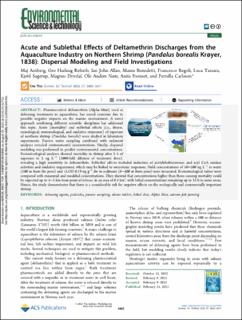| dc.contributor.author | Arnberg, Maj | |
| dc.contributor.author | Refseth, Gro Harlaug | |
| dc.contributor.author | Allan, Ian John | |
| dc.contributor.author | Benedetti, Maura | |
| dc.contributor.author | Regoli, Francesco | |
| dc.contributor.author | Tassara, Luca | |
| dc.contributor.author | Sagerup, Kjetil | |
| dc.contributor.author | Drivdal, Magnus | |
| dc.contributor.author | Nøst, Ole Anders | |
| dc.contributor.author | Evenset, Anita | |
| dc.contributor.author | Carlsson, Pernilla | |
| dc.date.accessioned | 2023-09-21T13:17:19Z | |
| dc.date.available | 2023-09-21T13:17:19Z | |
| dc.date.created | 2023-03-17T08:41:47Z | |
| dc.date.issued | 2023 | |
| dc.identifier.citation | Environmental Science and Technology. 2023, 57 (9), 3602-3611. | en_US |
| dc.identifier.issn | 0013-936X | |
| dc.identifier.uri | https://hdl.handle.net/11250/3091114 | |
| dc.description.abstract | Pharmaceutical deltamethrin (Alpha Max), used as delousing treatments in aquaculture, has raised concerns due to possible negative impacts on the marine environment. A novel approach combining different scientific disciplines has addressed this topic. Acute (mortality) and sublethal effects (i.e., fitness, neurological, immunological, and oxidative responses) of exposure of northern shrimp (Pandalus borealis) were studied in laboratory experiments. Passive water sampling combined with sediment analyses revealed environmental concentrations. Finally, dispersal modeling was performed to predict environmental concentrations. Ecotoxicological analyses showed mortality in shrimp after 1 h of exposure to 2 ng L–1 (1000-fold dilution of treatment dose), revealing a high sensitivity to deltamethrin. Sublethal effects included induction of acetylcholinesterase and acyl CoA oxidase activities and oxidative impairment, which may be linked to neurotoxic responses. Field concentrations of 10–200 ng L–1 in water (100 m from the pens) and <LOD-0.19 ng g–1 dw in sediment (0–400 m from pens) were measured. Ecotoxicological values were compared with measured and modeled concentrations. They showed that concentrations higher than those causing mortality could be expected up to 4–5 km from point of release, in an area of 6.4 km2, with lethal concentrations remaining up to 35 h in some areas. Hence, the study demonstrates that there is a considerable risk for negative effects on the ecologically and commercially important shrimp. | en_US |
| dc.language.iso | eng | en_US |
| dc.publisher | ACS Publications | en_US |
| dc.rights | Navngivelse 4.0 Internasjonal | * |
| dc.rights.uri | http://creativecommons.org/licenses/by/4.0/deed.no | * |
| dc.title | Acute and Sublethal Effects of Deltamethrin Discharges from the Aquaculture Industry on Northern Shrimp (Pandalus borealis Krøyer, 1838): Dispersal Modeling and Field Investigations | en_US |
| dc.type | Peer reviewed | en_US |
| dc.type | Journal article | en_US |
| dc.description.version | publishedVersion | en_US |
| dc.rights.holder | © 2023 The Authors | en_US |
| dc.source.pagenumber | 3602-3611 | en_US |
| dc.source.volume | 57 | en_US |
| dc.source.journal | Environmental Science and Technology | en_US |
| dc.source.issue | 9 | en_US |
| dc.identifier.doi | 10.1021/acs.est.2c07459 | |
| dc.identifier.cristin | 2134628 | |
| cristin.ispublished | true | |
| cristin.fulltext | original | |
| cristin.qualitycode | 2 | |

